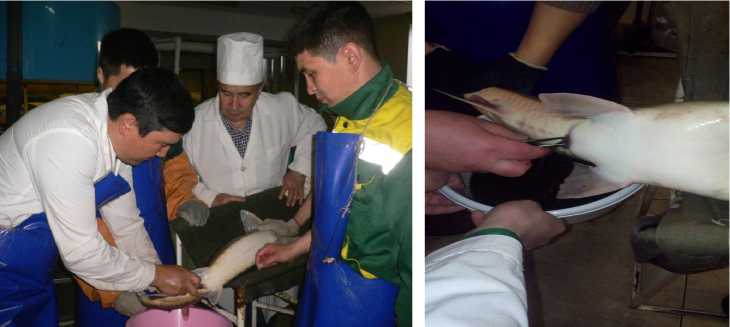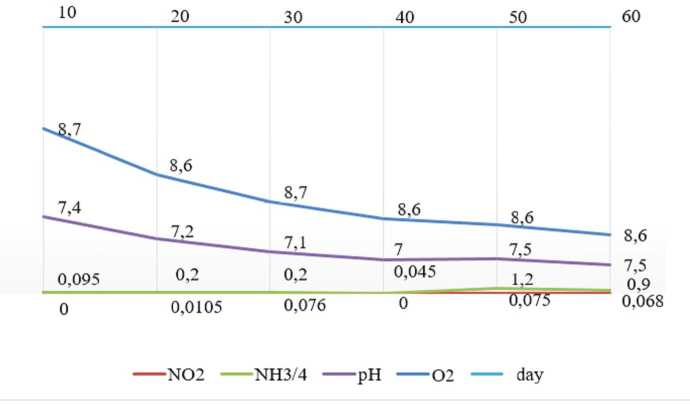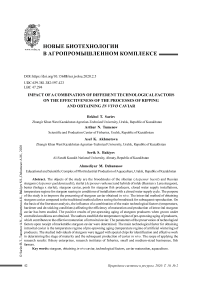Impact of a combination of different technological factors on the effectiveness of the processes of ripping and obtaining in vivo caviar
Автор: Sariev Bekbol T., Tumenov Arthur N., Akhmetova Asel K., Bakiyev Serik S., Dzhunusov Ahmediyar M.
Журнал: Природные системы и ресурсы @ns-jvolsu
Рубрика: Новые биотехнологии в агропромышленном комплексе
Статья в выпуске: 2 т.10, 2020 года.
Бесплатный доступ
The objects of the study are the broodstocks of the siberian (Acipenser baerii) and Russiansturgeon (Acipenser gueldenstaedtii), sterlet (Acipenser ruthenus) and hybrids of rolek (Russian x Lena sturgeon),bester (beluga x sterlet), sturgeon caviar, pools for sturgeon fish producers, closed water supply installations,temperature regime for sturgeon rearing in conditions of installations with a closed water supply cycle. The purposeof the study is to improve the processing of sturgeon caviar obtained in vivo. The intravital method of obtainingsturgeon caviar compared to the traditional method allows saving the broodstock for subsequent reproduction. Onthe basis of the literature analysis, the influence of a combination of the main technological factors (temperature,hardener and de-sticking conditions) affecting the efficiency of maturation and production of intravital sturgeoncaviar has been studied. The positive results of pre-spawning aging of sturgeon producers when grown undercontrolled conditions are obtained. The authors establish the temperature regime of pre-spawning aging of producers,which contributes to the effective maturation of intravital caviar. The parameters of the preservation of technologicalfactors upon receipt of marketable sturgeon caviar were determined. The main technological factor for obtainingintravital caviar is the temperature regime of pre-spawning aging (temperature regime of artificial wintering) ofproducers. The studied individuals of sturgeon were tagged with special chips for identification and effective workin determining the stage of maturity and the subsequent production of caviar in vivo. The scope of applying theresearch results: fishery enterprises, research institutes of fisheries, small and medium-sized businesses, fishfarmers.
Sturgeon, obtaining in vivo caviar, technological factors, caviar maturation, aquaculture
Короткий адрес: https://sciup.org/149129641
IDR: 149129641 | УДК: 639.381.382:597.423 | DOI: 10.15688/nsr.jvolsu.2020.2.5
Текст научной статьи Impact of a combination of different technological factors on the effectiveness of the processes of ripping and obtaining in vivo caviar
DOI:
Цитирование. Сариев Б. Т., Туменов А. Н., Ахметова А. К., Бакиев С. С., Джунусов А. М. Воздействие комбинации различных технологических факторов на эффективность процессов созревания и получения икры, добытой in vivo // Природные системы и ресурсы. – 2020. – Т. 10, № 2. – С. 42–50. – (На англ. яз.). – DOI:
Introduction. Among sturgeon products, caviar is most in demand. Caviar is the most valuable part of fish in gustatory and commercial terms.
In recent years, in connection with a significant decrease in the number of sturgeon fish in the natural range and the growing demand for the products of these fish species, in various regions quite valuable fish breeding is practiced under aquaculture conditions.
The methods of intravital production of ovulated eggs allow full use of the reproductive potential of females during their repeated maturation [1; 3; 7]. However, it should be noted that along with the obvious advantages of intravital caviar, there is a significant drawback – the surface of the caviar shell has a stickiness that occurs after eggs enter the water [4].
The stickiness of the shell creates significant difficulties and does not allow the use of the traditional method of preserving caviar.
In this connection, the improvement of the processing technology for sturgeon caviar obtained in vivo is relevant
The aim of the study was to improve the technology for processing the caviar obtained in vivo .
Scientific novelty lies in the improvement of the technological regulations for the processing of the caviar obtained in vivo .
The study of the influence of temperature conditions on the quality of the finished product and the study of the impact of various organizational, technical and sanitary measures on the organoleptic properties of intravital sturgeon caviar will provide opportunities for further research on the processing and storage of agricultural products.
Material and research technique. The study was conducted on the basis of the engineering biotechnology laboratory of the NCJSC “Zhangir Khan West Kazakhstan Agrarian-Technical University” and LLP “Educational and Scientific Complex of Pilot Industrial Production of Aquaculture” (Uralsk).
The studies were carried out in the framework of the grant-funding program of the Science Committee of the Ministry of Education and Science of the Republic of Kazakhstan on the topic IRN AP05135607 “Improving the processing technology of sturgeon caviar obtained in vivo ”.
The research material was the repair and uterine group Acipenser rutuenus L., Huso huso L., Acipenser baerii Brandt, Acipenser gueldenstaedtii Brandt et Ratzeburg and hybrid forms (Fig. 1).
The installation consisted of 2 x 2 x 0.7 and 3 x 5 x 0.7 m pools with rounded corners, a storage tank, a mechanical and biological treatment and water treatment unit. For fish cultivation, fish breeding pools were used, made of fiberglass reinforced polyester used in the food industry, equipped with a pit to remove residual feed and excrement.

Fig. 1. Intravital method of obtaining caviar
Preliminary selection of mature manufacturers was carried out using an ultrasound scanner. Manufacturers selected using an ultrasound scanner were biopsied, that is, oocytes (eggs) were taken to determine the polarization coefficient using a probe [6]. After determining the coefficient of polarization (Cp) according to the recommendations of M.S. Chebanov [2] females were divided into groups according to fish identification numbers. To obtain mature sexual products, groups 2, 3 and 4 were used, where Cp met the following criteria: 0.05d ≤ Cp<0.10, 0.10d ≤ Cp<0.12 and 0.12d ≤ Cp <0.15. The next stage in the biotechnology of obtaining intravital caviar is the wintering of producers (Fig. 2).
The main criterion for choosing the mode of pre-spawning maturation of mature females in the practice of fish farmers is the values of polarization coefficients (Cp) obtained by biopsy.
The duration of pre-spawning aging for sturgeon producers is the heat reserve, which is calculated in degree days. Deviation from the spawning regime leads to desynchronization of oocyte maturation and, as a result, to a decrease in the quality of eggs obtained.
In conditions of closed water supply installations, an artificial wintering was carried out to optimize the endocrine system. In specially equipped pools with cooling systems, manufacturers were kept in the pre-spawning period, and the water temperature was reduced to 4–6°C gradually, over ten days, by 1–2°C per day. At 4– 6°C, the fish were kept for 28–30 days, then gradually within two weeks the temperature was raised to spawning 14–15°C. During the period of keeping the producers, the synchronization of the polarization indicators of the oocytes in females occurred. With the achievement of spawning temperature, the producers were prepared for hormonal stimulation.
Research results and discussion. During the wintering period, it is necessary to take into account abiotic factors and monitor the parameters of the aquatic environment. The composition of the aqueous medium in specialized systems and installations is formed under the influence of the following factors: quality and composition of the water entering the system, regulation of temperature, hydrochemical and oxygen conditions.
During pre-spawning aging of producers, it is necessary to constantly monitor the hydrochemical regime, since at low temperatures the biofilter, which turns nitrites into nitrates (less dangerous for fish) does not function normally. Therefore, jumps are possible in the direction of an increase in the concentration of nitrites (see Fig. 3).
The saturation of water with oxygen in fish tanks (chiller) ranged from 78 to 98%. Such an oxygen regime is favorable for cultivated objects. The amount of nitrite, the most dangerous for fish, was within the permissible norm of 0.095 mg / dmі. At the same time, ammonia nitrogen is less dangerous for fish, but with an increase in the permissible norm, the values of ammonia nitrogen can affect pH fluctuations in water. During the wintering period at a temperature of + 5-6°С, feeding was not carried out and therefore the values of ammonium nitrogen did not exceed the established norms of maximum permissible concentrations.
Fluctuation of the pH of the medium was on average 7.5, which is optimal for farmed fish, as well as for the development of nitrifying bacteria (Table 1).
With hormonal stimulation of spawning by pituitary preparations, fractional injections should

Fig. 2. Wintering of producers in special pools and catch of sturgeon producers (chiller)
be preferred. The total dose of the drug depends on the temperature of the water and the weight of the fish, and the proportion of the preliminary injection depends on the degree of maturation of the oocytes, estimated by the value of the polarization coefficient.
The females were stimulated with hormonal preparations at a water temperature of 14°C, in stages, combining hormonal preparations. A preliminary injection was carried out with a pituitary suspension of mature cyprinid fish at a dose of 0.6 mg / kg body weight, and a resolving injection was carried out with the synthetic drug “Surfagon” at a dose of 4.0 мg / kg, with an interval between injections of 12 hours (Table 2).

Fig. 3. Hydrochemical analysis of wintering of producers in special pools (chiller)
Table 1
Hydrochemical indicators in special pools (chiller)
|
Indicators |
Technological norm on average |
|
рН |
7.5 |
|
Saturation of water with oxygen in fish tanks, % |
87-95 |
|
Turbidity, mg / dm³ |
– |
|
Nitrites, mg / dm³ |
0.76 |
|
Ammonium nitrogen, mg / dm³ |
0.2-0.9 |
Table 2
Grouping and identify potential of sexually mature fish
|
№ |
Fish species |
Identification number |
Cp |
L/ l |
Category |
Recommend ations for use |
Results, weight, raw caviar (kg) |
|
|
1 |
2 |
3 |
4 |
5 |
6 |
7 |
8 |
9 |
|
1 |
Siberian sturgeon |
0006B2AA78 |
0.26 |
4.9/1.3 |
$ |
Immature |
Back to the fish tank |
– |
|
2 |
Siberian sturgeon |
0006B29454 |
0.3 |
5.6/1.7 |
$ |
Overripe |
Back to the fish tank |
– |
|
3 |
Bester (beluga x sterlet) |
00074FF71E |
0.25 |
5.8/1.5 |
$ |
Immature |
Back to the fish tank |
– |
|
4 |
Siberian sturgeon |
0006B2BE7D |
0.24 |
6.1/1.5 |
$ |
Immature |
Back to the fish tank |
– |
|
5 |
Siberian sturgeon |
0006B2B9C4 |
0.16 |
4.9/0.8 |
Capable of maturation |
Sent to artificial winter |
0.500 |
Continuation of Table 2
|
№ |
Fish species |
Identification number |
Cp |
L/ l |
9/ s |
Category |
Recommend ations for use |
Results, weight, raw caviar (kg) |
|
1 |
2 |
3 |
4 |
5 |
6 |
7 |
8 |
9 |
|
6 |
Siberian sturgeon |
0006B2A8A3 |
0.19 |
4.6/0.9 |
9 |
Mature 1 |
Sent to artificial winter |
1.140 |
|
7 |
Siberian sturgeon |
0006B62CD64 |
0.4 |
5/2 |
9 |
Overripe |
Back to the fish tank |
– |
|
8 |
Siberian sturgeon |
00074C41B1 |
0.12 |
6.4/0.8 |
9 |
Close to maturation |
Sent to artificial winter |
0.595 |
|
9 |
Siberian sturgeon |
0006B2A559 |
0.2 |
5.3/1.1 |
9 |
Overripe |
Back to the fish tank |
– |
|
10 |
Siberian sturgeon |
0006B27520 |
0.12 |
5.1/0.6 |
9 |
Close to maturation |
Sent to artificial winter |
0.806 |
|
11 |
Rolek (Russian x Lena sturgeon) |
00074FE4C8 |
0.18 |
6.4/1.2 |
9 |
Mature 1 |
Sent to artificial winter |
2.149 |
|
12 |
Siberian sturgeon |
0006B2CD64 |
0.26 |
6/1.6 |
9 |
Immature |
Back to the fish tank |
– |
|
13 |
Sterlet |
0006B2BB2B |
0.11 |
4.6/0.5 |
9 |
Mature 2 |
Sent to artificial winter |
0.640 |
|
14 |
Bester (beluga x sterlet) |
0006E9BOC2 |
0.06 |
6/0.4 |
9 |
Mature 1 |
Sent to artificial winter |
0.270 |
|
15 |
Siberian sturgeon |
0005E9BF97 |
0.29 |
5.4/1.6 |
9 |
Immature |
Back to the fish tank |
– |
|
16 |
Bester (beluga x sterlet) |
00074C3CEF |
0.13 |
6/0.8 |
9 |
Close to maturation |
Sent to artificial winter |
0.684 |
|
17 |
Sterlet |
0006E9E155 |
0.26 |
5.4/1.4 |
9 |
Immature |
Back to the fish tank |
– |
|
18 |
Rolek (Russian x Lena sturgeon) |
00074D31AO |
0.14 |
5.6/0.8 |
9 |
Close to maturation |
Sent to artificial winter |
0.736 |
|
19 |
Sterlet |
0006E9C1B1 |
0.32 |
5/1.6 |
9 |
Immature |
Back to the fish tank |
– |
|
20 |
Sterlet |
00074D2D06 |
0.3 |
5/1.5 |
9 |
Overripe |
Back to the fish tank |
– |
|
21 |
Rolek (Russian x Lena sturgeon) |
0006E9CB7F |
0.22 |
5/1.1 |
9 |
Immature |
Back to the fish tank |
– |
|
22 |
Siberian sturgeon |
– |
– |
– |
a |
Immature |
Back to the fish tank |
– |
|
23 |
Siberian sturgeon |
– |
– |
– |
a |
Immature |
Back to the fish tank |
– |
|
24 |
Sterlet |
006E9D0F3 |
0.13 |
4.5/0.13 |
9 |
Close to maturation |
Sent to artificial winter |
The planned time did not give the caviar |
End of Table 2
As a result, 80% of producers in the interval up to 38 hours gave caviar. Mature sex products were obtained by the intravital method; the total mass of raw caviar was 8 kg.
Thus, it was found that the optimal polarization coefficient of oocytes for the selection of manufacturers ranges from 0.06 to 0.16 Cp. It was determined that the optimal duration of prespawning aging depending on the polarization of oocytes is 50–58 days. The aging temperature varies from 5°C to 20°C [5].
Conclusion. As a result of the research, the wintering period was shown during which abiotic factors were taken into account, and the parameters of the aquatic environment were monitored. The saturation of water with oxygen in fish tanks (chiller) ranged from 78 to 98%. Such an oxygen regime is favorable for cultivated objects. The amount of nitrite, the most dangerous for fish, was within the permissible norm of 0.095
mg/dmі. During the wintering period at a temperature of + 5–6°С, feeding was not carried out and therefore the values of ammonium nitrogen did not exceed the established norms of maximum permissible concentrations. Fluctuations in the pH of the medium were on average 7.5, which is optimal for farmed fish, as well as for the development of nitrifying bacteria.
The females were stimulated with hormonal preparations at a water temperature of 14°C, in stages, combining hormonal preparations. A preliminary injection was carried out with a pituitary suspension of mature cyprinid fish at a dose of 0.6 mg/kg body weight, and a resolving injection was carried out with the synthetic drug “Surfagon” at a dose of 4.0 мg/kg, with an interval between injections of 12 hours.
The main technological factor for obtaining intravital caviar is the temperature regime of prespawning aging (temperature regime of artificial
Список литературы Impact of a combination of different technological factors on the effectiveness of the processes of ripping and obtaining in vivo caviar
- Burcev I.A. Poluchenie potomstva ot mezhvidovogo gibrida belugi so sterlyadyu [Getting Offspring from an Interspecific Hybrid of a Beluga with a Sterlet]. Genetika, selektsiya i gibridizatsiya ryb [Genetics, Selection and Hybridization of Fish]. Moscow, Nauka, 1969, pp. 232-242.
- Chebanov M.S. Rukovodstvo po iskusstvennomu vosproizvodstvu osetrovykh ryb [Guidelines for Artificial Reproduction of Sturgeons]. Prodovolstvennaya i selskohozyajstvennaya organizatsiya OON Ankara [UN Food and Agriculture Organization Ankara], 2010, pp. 252-280.
- Kokoza A.A., Izmajlova. N.A. Iskusstvennoe vosproizvodstvo osetrovykh [Artificial Reproduction of Sturgeons]. Astrakhan, Rybnoe hozyaystvo, 1995, pp. 27-28.
- Kopylenko L.R., Koryazova I.L. Sposob polucheniya zernistoy ikry iz ovulirovavshey ikry osetrovykh ryb [Method for Producing of Granular Caviar from Ovulated Sturgeon Roe]. URL: https://patents.google.com/patent/RU2232523C2/en.
- Sariev B.T. Sovershenstvovanie tekhnologii pererabotki ikry osetrovykh, poluchennoy prizhiznennym sposobom [Improving the Processing Technology of Sturgeon Caviar Obtained in vivo]. AO "Nac. centr nauchno-tekhn. inform": ruk. Sariev B. T.; ispoln.: Tumenov A. N. - Uralsk [JSC "National Center of Scientific and Technical Inform". Leader. Sariev B.T; Performer: A. Tumenov - Uralsk], 2019, pp. 14-24. № GR 0118RK00865. Inv. № 0219РК01277.
- Sariev B.T., Tumenov A.N., Bakiyev S.S., Dzhunusov A.M. Bekiretuqymdas balyqtardyń jynys ónimderiniń kezeńderin últradybystyq zertteý kómegimen anyqtaýdyń týimdiligi [The Effectiveness of the Determination of the Stages of Sexual Production of Sturgeon by Ultrasound]. Bilim jáne gylym [Education and Science], 2018, vol. 3, no. 52, pp.160-167.
- Sluckaya T. Poluchenie zernistoy ikry iz osetrovykh iskusstvennogo vyrashchivaniya [Obtaining Granular Caviar from Sturgeon Artificial Cultivation]. Izvestiya TINRO [News of Pacific Fisheries Research Center], 2012, pp. 286-297.


